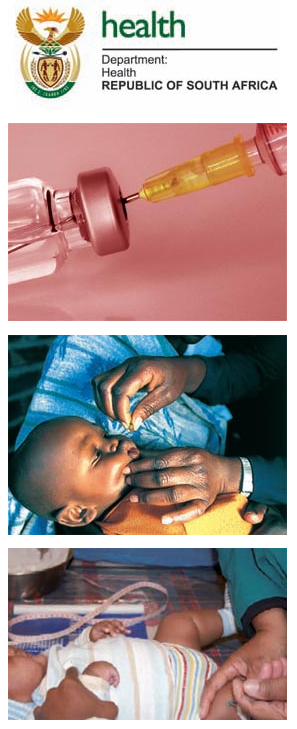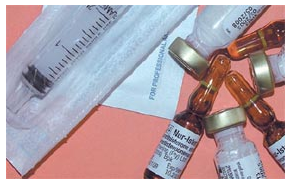 Vaccines are one of the most important ways to help prevent infectious diseases. In the past, before there were vaccines, many children died or had severe complications following infections.
Vaccines are one of the most important ways to help prevent infectious diseases. In the past, before there were vaccines, many children died or had severe complications following infections.
Parents and care-givers of children are urged to ensure that their children receive all their vaccines at the right age. This can be done by checking your child's Road to Health/Immunisation card. If you are not sure, you can check at your local clinic.
What is polio?
Polio is a highly infectious disease caused by a virus. It invades the nervous system, and can cause a person to become totally paralysed within hours. Initial symptoms are fever, tiredness, headache, vomiting, stiffness in the neck and pain in the limbs. Polio mainly affects children under five years old. There is no cure for polio but it can be prevented by the polio vaccine, given multiple times. This can protect a child for life.
What is pneumonia?
Pneumonia is a form of acute infection in the lungs. When a person has pneumonia, the small lung sacs called alveoli are filled with pus and fluid, which makes it difficult to breathe. Pneumonia is the single largest cause of death in children worldwide.
What is tetanus?
Tetanus, commonly called 'lockjaw', affects the nervous system. People can get it through a cut or wound that becomes infected with tetanus bacteria (germs), mostly found in soil, dust or manure. It can get in through even a tiny hole or scratch, but deep wounds or cuts are more easily infected. It causes severe muscle spasms, leading to 'locking' of the jaw so the patient cannot open his or her mouth or swallow. It may lead to death by suffocation.
What is tuberculosis?
Tuberculosis (TB) is a contagious disease. Like the common cold, it spreads through the air. Only people who are sick with TB in their lungs are infectious. When infected people cough, sneeze, talk or spit, they send TB germs, known as bacilli, into the air. A person needs only to inhale a small number of these to be infected.
What is measles?
Measles is a highly infectious disease caused by a virus. Signs of measles are high fever, fine red rash and cold-like symptoms - cough, runny nose and watery red eyes. Measles can cause complications like pneumonia, deafness and death. Measles is one of the leading causes of death among young children globally, despite the availability of a vaccine.
What is diphtheria?
Diphtheria is an infectious disease spread from person to person by droplets from the throat through coughing and sneezing. Diphtheria usually affects the tonsils, throat, voice box and sometimes the skin. Symptoms include sore throat, fever, neck swelling, difficulty swallowing and breathing and weakness. People can die from the disease.
What is mumps?
 Mumps is an infection caused by a virus and is mostly a mild childhood disease. The mumps virus usually affects children between five and nine years old, but it can infect adults as well. It is spread by droplets released in the air when an infected person sneezes or coughs and by direct contact with an infected person.
Mumps is an infection caused by a virus and is mostly a mild childhood disease. The mumps virus usually affects children between five and nine years old, but it can infect adults as well. It is spread by droplets released in the air when an infected person sneezes or coughs and by direct contact with an infected person.
What is rubella (German measles)?
Rubella is an infection caused by a virus. It is spread through the air when infected people sneeze or cough. Congenital rubella syndrome (CRS) is an important cause of severe birth defects. When a woman is infected with the rubella virus early in pregnancy, she has a 90 per cent chance of passing the virus on to her unborn baby. This can cause the death of the unborn baby. Even though it is a mild childhood disease, CRS causes birth defects like deafness. It can also cause defects in the eyes, heart, and brain.
What is hepatitis B?
Hepatitis B is a potentially life-threatening liver infection caused by the hepatitis B virus. It is a major global health problem and the most serious type of viral hepatitis. It can cause chronic liver disease and puts people at high risk of death from cirrhosis of the liver and liver cancer.
What is whooping cough (pertussis)?
Whooping cough - or pertussis - is an infection of the respiratory (breathing) system. It causes severe coughing spells that end in a "whooping" sound when the person breathes in. It is very contagious. The germs are spread from person to person through tiny drops of fluid from an infected person's nose or mouth when the person sneezes, coughs, or laughs. Other people can become infected by breathing in the drops or getting the drops on their hands and then touching their mouths or noses.
| DISEASE | VACCINATION | AGE |
| Polio | TOPV | Oral drops at birth and repeated at six, 10 and 14 weeks, 18 months and five years |
| Tuberculosis | BCG (bacillus Calmette-Guérin vaccine) | Birth |
| Diphtheria | DPT (diphtheria, tetanus, pertussis [whooping cough] vaccine) | Six weeks and repeated at 10 and 14 weeks, 18 months and five years |
| Whooping cough or pertussis | DTP (diphtheria, tetanus, pertussis [whooping cough] vaccine) | Six weeks and repeated at 10 and 14 weeks, and 18 months |
| Tetanus | DTP (diphtheria, tetanus, pertussis [whooping cough] vaccine) | Six weeks and repeated at 10 and 14 weeks, 18 months and five years |
| Hepatitis B | HBV (hepatitis B vaccine) | Six weeks and repeated at 10 and 14 weeks |
| Meningitis/severe pneumonia | Hib (haemophilus influenza group b [meningitis] vaccine) | Six weeks and repeated at 10 and 14 weeks |
| Measles | Measles vaccine | Nine months and repeated at 18 months and in combination with MMR at 15 months |
| Mumps | MMR (mumps, measles and rubella [German measles]) vaccine | 15 months |
| Rubella (German measles) | MMR (mumps, measles and rubella [German measles]) vaccine | 15 months |
For more information, visit the Department of Health's website: www.doh.gov.za, or call 012 312-3174



 Facebook
Facebook Twitter
Twitter WhatsApp
WhatsApp